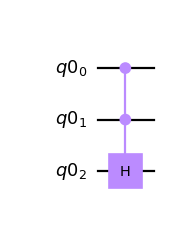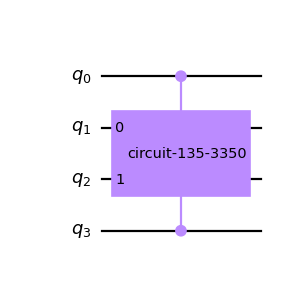ControlledGate#
- class qiskit.circuit.ControlledGate(name, num_qubits, params, label=None, num_ctrl_qubits=1, definition=None, ctrl_state=None, base_gate=None)[소스]#
기반 클래스:
GateControlled unitary gate.
Create a new ControlledGate. In the new gate the first
num_ctrl_qubitsof the gate are the controls.- 매개변수:
name (str) – The name of the gate.
num_qubits (int) – The number of qubits the gate acts on.
params (list) – A list of parameters for the gate.
label (Optional[str]) – An optional label for the gate.
num_ctrl_qubits (Optional[int]) – Number of control qubits.
definition (Optional['QuantumCircuit']) – A list of gate rules for implementing this gate. The elements of the list are tuples of (
Gate(), [qubit_list], [clbit_list]).ctrl_state (Optional[Union[int, str]]) – The control state in decimal or as a bitstring (e.g. ‘111’). If specified as a bitstring the length must equal num_ctrl_qubits, MSB on left. If None, use 2**num_ctrl_qubits-1.
base_gate (Optional[Gate]) – Gate object to be controlled.
- 예외 발생:
CircuitError – If
num_ctrl_qubits>=num_qubits.CircuitError – ctrl_state < 0 or ctrl_state > 2**num_ctrl_qubits.
Examples:
Create a controlled standard gate and apply it to a circuit.
from qiskit import QuantumCircuit, QuantumRegister from qiskit.circuit.library.standard_gates import HGate qr = QuantumRegister(3) qc = QuantumCircuit(qr) c3h_gate = HGate().control(2) qc.append(c3h_gate, qr) qc.draw('mpl')

Create a controlled custom gate and apply it to a circuit.
from qiskit import QuantumCircuit, QuantumRegister from qiskit.circuit.library.standard_gates import HGate qc1 = QuantumCircuit(2) qc1.x(0) qc1.h(1) custom = qc1.to_gate().control(2) qc2 = QuantumCircuit(4) qc2.append(custom, [0, 3, 1, 2]) qc2.draw('mpl')

Attributes
- condition_bits#
Get Clbits in condition.
- ctrl_state#
Return the control state of the gate as a decimal integer.
- decompositions#
Get the decompositions of the instruction from the SessionEquivalenceLibrary.
- definition#
Return definition in terms of other basic gates. If the gate has open controls, as determined from self.ctrl_state, the returned definition is conjugated with X without changing the internal _definition.
- duration#
Get the duration.
- label#
Return instruction label
- name#
Get name of gate. If the gate has open controls the gate name will become:
<original_name_o<ctrl_state>
where <original_name> is the gate name for the default case of closed control qubits and <ctrl_state> is the integer value of the control state for the gate.
- num_clbits#
Return the number of clbits.
- num_ctrl_qubits#
Get number of control qubits.
- 반환:
The number of control qubits for the gate.
- 반환 형식:
- num_qubits#
Return the number of qubits.
- params#
Get parameters from base_gate.
- 반환:
List of gate parameters.
- 반환 형식:
- 예외 발생:
CircuitError – Controlled gate does not define a base gate
- unit#
Get the time unit of duration.
Methods
- add_decomposition(decomposition)#
Add a decomposition of the instruction to the SessionEquivalenceLibrary.
- assemble()#
Assemble a QasmQobjInstruction
- broadcast_arguments(qargs, cargs)#
Validation and handling of the arguments and its relationship.
For example,
cx([q[0],q[1]], q[2])meanscx(q[0], q[2]); cx(q[1], q[2]). This method yields the arguments in the right grouping. In the given example:in: [[q[0],q[1]], q[2]],[] outs: [q[0], q[2]], [] [q[1], q[2]], []
The general broadcasting rules are:
If len(qargs) == 1:
[q[0], q[1]] -> [q[0]],[q[1]]
If len(qargs) == 2:
[[q[0], q[1]], [r[0], r[1]]] -> [q[0], r[0]], [q[1], r[1]] [[q[0]], [r[0], r[1]]] -> [q[0], r[0]], [q[0], r[1]] [[q[0], q[1]], [r[0]]] -> [q[0], r[0]], [q[1], r[0]]
If len(qargs) >= 3:
[q[0], q[1]], [r[0], r[1]], ...] -> [q[0], r[0], ...], [q[1], r[1], ...]
- c_if(classical, val)#
Set a classical equality condition on this instruction between the register or cbit
classicaland valueval.참고
This is a setter method, not an additive one. Calling this multiple times will silently override any previously set condition; it does not stack.
- control(num_ctrl_qubits=1, label=None, ctrl_state=None)#
Return controlled version of gate. See
ControlledGatefor usage.- 매개변수:
- 반환:
Controlled version of gate. This default algorithm uses
num_ctrl_qubits-1ancilla qubits so returns a gate of sizenum_qubits + 2*num_ctrl_qubits - 1.- 반환 형식:
- 예외 발생:
QiskitError – unrecognized mode or invalid ctrl_state
- copy(name=None)#
Copy of the instruction.
- 매개변수:
name (str) – name to be given to the copied circuit, if
Nonethen the name stays the same.- 반환:
a copy of the current instruction, with the name updated if it was provided
- 반환 형식:
- is_parameterized()#
Return True .IFF. instruction is parameterized else False
- power(exponent)#
Creates a unitary gate as gate^exponent.
- 매개변수:
exponent (float) – Gate^exponent
- 반환:
To which to_matrix is self.to_matrix^exponent.
- 반환 형식:
- 예외 발생:
CircuitError – If Gate is not unitary
- qasm()#
Return a default OpenQASM string for the instruction.
Derived instructions may override this to print in a different format (e.g.
measure q[0] -> c[0];).버전 0.25.0부터 폐지됨: The method
qiskit.circuit.instruction.Instruction.qasm()is deprecated as of qiskit-terra 0.25.0. It will be removed no earlier than 3 months after the release date. Correct exporting to OpenQASM 2 is the responsibility of a larger exporter; it cannot safely be done on an object-by-object basis without context. No replacement will be provided, because the premise is wrong.
- repeat(n)#
Creates an instruction with gate repeated n amount of times.
- 매개변수:
n (int) – Number of times to repeat the instruction
- 반환:
Containing the definition.
- 반환 형식:
- 예외 발생:
CircuitError – If n < 1.
- reverse_ops()#
For a composite instruction, reverse the order of sub-instructions.
This is done by recursively reversing all sub-instructions. It does not invert any gate.
- 반환:
- a new instruction with
sub-instructions reversed.
- 반환 형식:
- soft_compare(other)#
Soft comparison between gates. Their names, number of qubits, and classical bit numbers must match. The number of parameters must match. Each parameter is compared. If one is a ParameterExpression then it is not taken into account.
- 매개변수:
other (instruction) – other instruction.
- 반환:
are self and other equal up to parameter expressions.
- 반환 형식:
- to_matrix()#
Return a Numpy.array for the gate unitary matrix.
- 반환:
if the Gate subclass has a matrix definition.
- 반환 형식:
np.ndarray
- 예외 발생:
CircuitError – If a Gate subclass does not implement this method an exception will be raised when this base class method is called.
- validate_parameter(parameter)#
Gate parameters should be int, float, or ParameterExpression